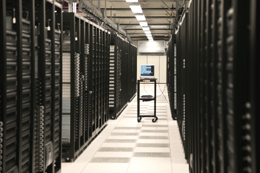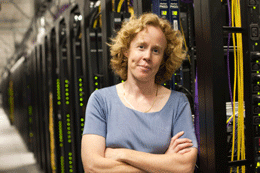Low-Carbon Internet Surfing
Air Date: Week of July 10, 2009

A Yahoo Sunnyvale Data center, nicknamed Space Park, houses some of your favorite web sites. (Courtesy of Yahoo)
All of the news, video and mail you access online has to live somewhere. These houses of information need large amounts of energy to run. Chris Page, Director of Climate and Energy Strategy at Yahoo!, gives host Jeff Young a tour of one such data center in Silicone Valley. She also talks about Yahoo’s plan for cutting their CO2 emissions in half.
Transcript
[SOUND OF DOOR OPENING, ROAR OF MACHINERY]
YOUNG: When you visit a web site or look up something online each click of the mouse makes a little more work for a place like this—a data center.
Former Living on Earth staffer Chris Page, who now works with Yahoo, gives us a virtual tour of Yahoo’s Sunnyvale data center in California.
PAGE: This is where the real work of the Internet happens. And what you’re basically hearing is all that cooling energy. You’ve got the fans running across the servers, which look like these humming boxes. They’re each about the size of a pizza box. And they’re in these racks. And the racks are in these aisles. And there are fans that suck the cold air from the air-handling units through the front of the servers and then spit the hot air out the back.

Chris Page is working to cut Yahoo's carbon footprint in half by 2014.(Courtesy of Yahoo)
[SOUND OF DOOR OPENING]
Back at her office, where we can actually hear, Page explains how Yahoo’s approach has evolved.
PAGE: Yahoo, basically – in 2007 we saw a problem we wanted to take action on immediately. And what we did was we bought offsets against out entire footprint, rendering us carbon neutral.
YOUNG: Hmm. And so, now you’re thinking no more carbon offsets, right?
PAGE: That’s right. The goal now is a 40 percent reduction in carbon intensity of our data centers by 2014. Effectively what that means is we’ll be providing the same amount of services or better in 2014 than we are today, but with 40 percent less carbon.
YOUNG: Of your carbon footprint, how much of it is just powering those big data centers, those servers?
PAGE: That’s one of the first things we discovered. The majority of it really is from data centers.
YOUNG: Hmm. And my guess is my individual contribution to that is not that great, but it adds up. How many yahoo users are there?
PAGE: We have over 500 million users worldwide.
YOUNG: Half a billion.
PAGE: Half a billion users worldwide. To give you an example: when Michael Jackson passed away recently we had 800,000 clicks on the front-page story about that within a ten minute time period.
YOUNG: Wow.
PAGE: So that’s a lot of people.
YOUNG: But you don’t always have that level of use, right?
PAGE: That’s correct.
YOUNG: But you have to plan for that level of use.
PAGE: Exactly. That’s where one of the opportunities is in terms of efficiency. Historically, when you look at capacity in a server, you have to design a cathedral for Easter or Christmas. People are going to be using that way all the time. It’s Easter and Christmas only you don’t know what day of the year Easter and Christmas is going to fall on.

A Yahoo Sunnyvale Data center, nicknamed Space Park, houses some of your favorite web sites.(Courtesy of Yahoo)
YOUNG: Do we know how big the Internet is in terms of its energy use, its CO2 output?
PAGE: In 2007, the EPA noted that over the past five years, energy consumption from data centers in the United States had doubled and was 60 billion kilowatt hours for the country. And we’re expecting within the next five years to go up to 100 billion kilowatt hours. Historically with data centers, people really haven’t paid very close attention to electricity, so you wound up having sort of the equivalent of your mom’s wood panel station wagon, very reliable, but not necessarily designed for efficient miles per gallon. What we’re looking at in the next generation of data centers that Yahoo’s trying to build is really something closer to the Tesla. Still very efficient, even more reliable, and looking for ways to reduce the waste throughout the system as much as possible.
YOUNG: But the Tesla costs $100,000.
PAGE: Yeah, well that’s where the analogy kinda breaks down a little bit because it’s not actually that much more expensive. In some cases what you’re doing is actually saving money by eliminating things like very expensive chillers and relying instead on air cooling, free air cooling, as we’re going to do in the new design we have for our upstate New York facility.
YOUNG: Now this new one that you’re building, tell us more about that. Is that going to look significantly different or behave significantly differently from your other data centers?
PAGE: It will look a little bit like a chicken coop when it’s built. And it is oriented to take advantage of the microclimate in the area. Upstate New York can be a very chilly place. We’re going to be relying 100 percent of the time on free cooling, which will drastically improve the efficiency of it.
YOUNG: What does all this tell us about how information technology overlaps with energy technology and our efforts to get cleaner energy?
PAGE: Well I think you’re gonna see some tremendous developments in the next couple of years. The impact that all this technology will have in other areas, making transportation smarter, making buildings smarter so they’re cooling themselves in a much more efficient way. All those things together, smart logistics, smart buildings and the smart grid will decrease carbon emissions by 7.8 gigatons. So the contribution of the ICT industry will be 1.3 gigatons. The reduction will be 7.8 gigatons.
YOUNG: Wow.
PAGE: I think that’s one of the really powerful things about the Internet in general and companies like Yahoo is providing technology that can make the world run more efficiently, more smoothly and with better information.
YOUNG: Chris Page is Director of Climate and Energy Strategy at Yahoo Inc., thanks very much for your time.
PAGE: You bet.
CURWOOD: Coming up: the top rated green home in America – and at the top of its winning ways is plain old-fashioned insulation.
Keep listening to Living on Earth.
[MUSIC: Cal Green “Trippin’” from “Trippin' - The Groove Merchant Compilation”.]
Links
Yahoo's co-founder announces plans to build an energy efficient data center near Buffalo.
Living on Earth wants to hear from you!
Living on Earth
62 Calef Highway, Suite 212
Lee, NH 03861
Telephone: 617-287-4121
E-mail: comments@loe.org
Newsletter [Click here]
Donate to Living on Earth!
Living on Earth is an independent media program and relies entirely on contributions from listeners and institutions supporting public service. Please donate now to preserve an independent environmental voice.
NewsletterLiving on Earth offers a weekly delivery of the show's rundown to your mailbox. Sign up for our newsletter today!
 Sailors For The Sea: Be the change you want to sea.
Sailors For The Sea: Be the change you want to sea.
 The Grantham Foundation for the Protection of the Environment: Committed to protecting and improving the health of the global environment.
The Grantham Foundation for the Protection of the Environment: Committed to protecting and improving the health of the global environment.
 Contribute to Living on Earth and receive, as our gift to you, an archival print of one of Mark Seth Lender's extraordinary wildlife photographs. Follow the link to see Mark's current collection of photographs.
Contribute to Living on Earth and receive, as our gift to you, an archival print of one of Mark Seth Lender's extraordinary wildlife photographs. Follow the link to see Mark's current collection of photographs.
 Buy a signed copy of Mark Seth Lender's book Smeagull the Seagull & support Living on Earth
Buy a signed copy of Mark Seth Lender's book Smeagull the Seagull & support Living on Earth

